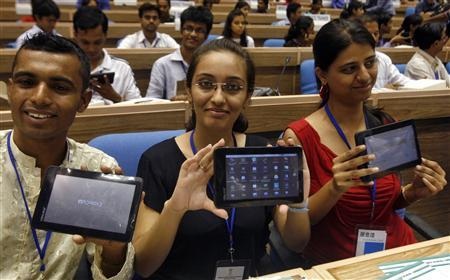India Introduces World's Cheapest Tablet PC at $35
Just today, the Aakash tablet launched in India. It’s a relatively small tablet, but it works and as part of a pilot program, 100,000 Indian students are getting them for free. After that, they’ll only be $35 for students and $60 for anyone else interested. Pretty cheap for a tablet that’s not a tablet of paper. Granted, the free and $35 tablets are being subsidized by the governement, but the tablets are being purchased at only $50 a pop from the British company assembling the devices on-sight in India. Still an order of magnitude less than your average tablet.
Of course, being an order of magnitude cheaper also comes with extremely stripped down functionality and usability, stripped down so far as to be a relatively serious concern. The tablet has two USB ports, a resistive LCD screen, a two to three hour battery life, wireless broadband capability (of course), and can even play video for two whole hours at the sweltering temperature of 118 degrees, but the tablet’s responsiveness and processing times are rumored to be atrocious.
The main goal of the tablet is to help incorporate information technology in Indian education, so the the low price point is key. It also allows for the use of digital textbooks which could be incredibly useful since no one wants to carry around heavy books in ridiculous heat. Using digital textbooks is also an activity that requires little in the way of processing power or responsiveness. Since the consumer models aren’t as insanely cheap as the subsidized student devices, they could manage to be slightly overpriced if the interface experience is frustrating. Still, India has an extremely low Internet connection rate, which the government is aiming to change. Only 8% of Indians have Internet access as compared to 40% of China.
It’s not likely that any one will be able to accurately predict the adoption rate of these tablets until the pilot program is over. The program will give plenty of people the chance to get their hands on one, seem them operate in the wild, and hear stories about their usability (or lack thereof) before deciding if they’re worth an investment. If it’s not mind bogglingly unusable, it’s probably a good cost-proposition at that low price point, but the real issue is summed up nicely by Nikant Vohra, an electrical engineering student interviewed by Reuters.
“It could be better. If you see it from the price only, it’s okay, but we have laptops and have used iPads, so we know the difference.”
When it comes to the Aakash, ignorance may turn out to be bliss.
(via Reuters)
- The Raspberry Pi micro-desktop is $10 cheaper AND can run Quake 3…
- The new Kindle Fire isn’t $35, but it’s still less than an iPad
- Windows 8 is revving up for the tablet game too. Everybody sure loves tablets
Have a tip we should know? tips@themarysue.com
